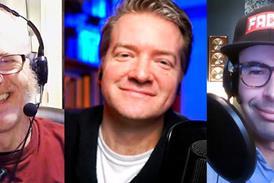The horrific terror attack of 9/11 cemented in Patrick Flynn’s mind that religion was not only untrue and irrelevant, but also troublesome. Jana Harmon explores how rigorous study and existential questions led Pat to change his mind
There are different stories we believe that help us make sense of the world around us and the world within us. Some are religious stories, some are scientific, cultural or secular stories. When it comes to the question of God and what ultimate reality is, oftentimes we adopt the stories and beliefs of those around us without giving them much thought. And we quickly dismiss other beliefs as false, without much intentional investigation to arrive at a thoughtful conclusion. We may find something wrong with the other and reject it without much effort to really find out what we are embracing or whether it is even true.
However, there are those who don’t just accept beliefs on face value. They are bent towards intellectual rigour and honesty, even if it takes them down an intellectual road they never thought they would go.
Philosopher and former atheist Pat Flynn thought carefully about things. Even as a child, he was haunted by the big questions of reality and existence. He wanted to make the best sense of reality, and it took him on an honest, diligent investigation, first towards naturalism and belief in atheism. But it was his continued thoughtful search for truth that led him out of atheism and towards belief in God. What made him change his mind?
Read more:
From secular humanism to Christianity
From radical atheist to Christian
From atheism to a life filled with meaning
Finding God through science
A thoroughly secular upbringing
From an early age, Pat was shown not to take religion seriously. When his grandparents were in town, his family would go to church on Christmas or Easter but nothing more than that. There was never any conversation about religion in his home apart from occasional jokes. It seemed unimportant, especially considering what he was learning in science class and the origin of the Universe through Big Bang cosmology, not creation.
The horrific terror attack of 9/11 also cemented in his mind that religion was not only untrue and irrelevant, but also troublesome. The profound problem of evil became palpable, unexplainable. It planted a “seed of doubt that would continue to grow over time” as he started to think more seriously about bigger questions, becoming more interested in philosophy. In his view, there were two different stories of reality being told that didn’t fit together:
“One of them (religion) seemed unimportant and trivial and outdated and that nobody around me took seriously, including my family, and the other one (science) seemed like the credible story that smart people believe. So, it was very easy for me to dismiss the other one.”
Pat also had a deep love for music and literature. Most of the music he was listening to as well as musicians and writers he admired seemed strongly anti-religious. Mark Twain’s essay ‘What is Man?’ persuaded Pat that man was a machine without free will, unable to affect history in any meaningful way. While this way of thinking seemed to go against his own basic intuitions and seeming free ability to choose, he accepted this way of thinking, nonetheless.
Pat also became fascinated by the writings of notable atheists like HL Mencken and Friedreich Nietzsche, “haunted” by their perspectives. He began to call himself a “naturalist”, believing that only the natural world exists. Nothing supernatural. There was no God.
Questioning naturalism
Over time, more and more tensions within the naturalist worldview were beginning to “bubble up” because he was interested in trying to make sense of reality. Even as a child, he looked out of the window and asked big questions like “Why is any of this?”, “How do I know any of this is real?” and “How do I know I’m not dreaming or sleeping?”.
As an adult, the more he ventured down the path of naturalism, the more he realised that a godless world seemed unable to explain some basic features of the world and of himself. He began to realise:
“This is not adequate to handle reality. This is not adequate to explain the things that I need to be explained for me. And in fact, it seems the deeper I go into this worldview, the more it has to eliminate or explain away things that are so fundamental, I don’t think they could be coherently denied, things like free will and consciousness. Consciousness was a big one for me. The moral landscape, the objective moral landscape of moral duties and values.
The more I kept going into this atheistic, naturalistic paradigm, the more it seemed like I was being forced, unless I was willing to really contrive the worldview and hypothesis, to say that these things aren’t what they seem to be, that these things aren’t real in the way that they sure seem to be real. They’re illusions, I’m suffering under delusions. Maybe I’m not even real. Maybe I’m just like a bundle of particles. And at some point, those tensions came to be too much, and I realised: ‘I don’t know what the truth is. I’ve been trying to find it. But this is definitely not it. Somewhere, I made a mistake and have set down the wrong path.’”
Pat moved from atheism to agnosticism. He didn’t immediately turn towards belief in God as an alternative, but he decided that he need to consider new perspectives. Perhaps there was a better explanation than naturalism, but he didn’t quite know which path to take.
Questing towards truth
Pat set off on a solitary journey to discover the best explanation for what he believed and experienced of the world. It was a “lonely study, largely conducted up in my attic in my old house for many, many years, reading and researching”. His “anti-Christian bias” first led him towards Eastern thought and paganism. He read works promoting religious pluralism, everything from Aldous Huxley, Aristotle and Plato. All of his reading led him to become intensely interested in “the God question” and projects of natural theology, recalling his questions:
“Is God something we can think about? Are there reasons to believe in God? And if so, can we know anything about God? Is there one? Is there more than one? Is God the Universe? Is pantheism true? Is monotheism true in some form or another? I became utterly fascinated with the God question first and foremost, because it seems the most fundamental.”
After much study, Pat was convinced that a robust monotheism was “the best explanatory worldview”. Far from firm commitments, he was still more attracted to the idea of religious pluralism. But once he was introduced to the works of Thomas Aquinas and other notable Christian philosophers and thinkers, he began to see how the great questions of life and reality were substantively answered in a coherent and comprehensive way that seemed to match with reality. Aquinas was able to answer the questions that had long eluded him, questions like ‘Why is there anything?’, ‘What are we?’ and ‘How are we supposed to live?’. Pat realised he had found answers that grounded his observations in science and in life itself, not evaded them.
After being dissatisfied with Eastern religions and paganism, he turned to take a serious look at Christianity, not only philosophically, but historically as well. It was then that he discovered other credible, rational reasons to believe the core claims of Christianity were true. For Pat, it became an “eminently reasonable” worldview.
Get access to exclusive bonus content & updates: register & sign up to the Premier Unbelievable? newsletter!
More than intellectual
Although Pat “worked his way” to the Christian perspective, not everything about his conversion was intellectual. The love in his life needed explanation, something he felt that he knew had to be more than “just axons firing for survival purposes”. There was a transcendent quality about it that seemed undeniable. It was “beyond explanation” yet intimate and real.
Pat came to believe that the foundation of reality not only explained the big questions, but was also “a fountain of self-donating love”. Love was not a delusion, as explained through a godless worldview, but was rather the experience of Love Himself, a personal God. Pat not only came to believe in God and Christianity, he came to love the one who was the source of love himself.
If you’d like to listen to Patrick Flynn tell his full story, tune into the Side B Stories Episode #78, 13 October, 2023. You can find it on the Side B Stories website www.sidebstories.com.
Jana Harmon hosts the Side B Stories podcast where former atheists and sceptics talk about their turn from disbelief to belief in God and Christianity. She is a teaching fellow for the CS Lewis Institute of Atlanta and former adjunct professor in cultural apologetics at Biola University where she received an MA in Christian apologetics. Jana also holds a PhD in religion and theology from the University of Birmingham in England. Her research focused on religious conversion of atheists to Christianity and related book is entitled Atheists Finding God: Unlikely Stories of Conversions to Christianity in the Contemporary West.























